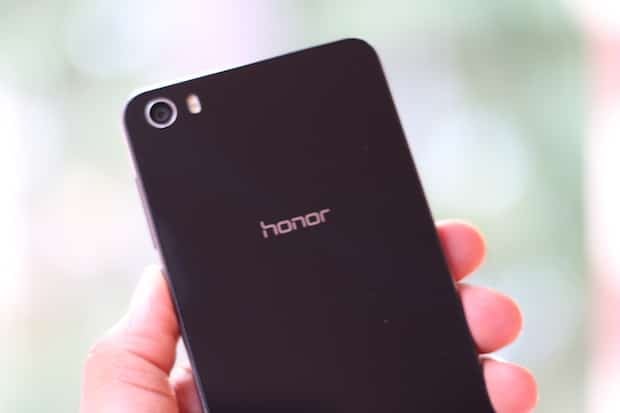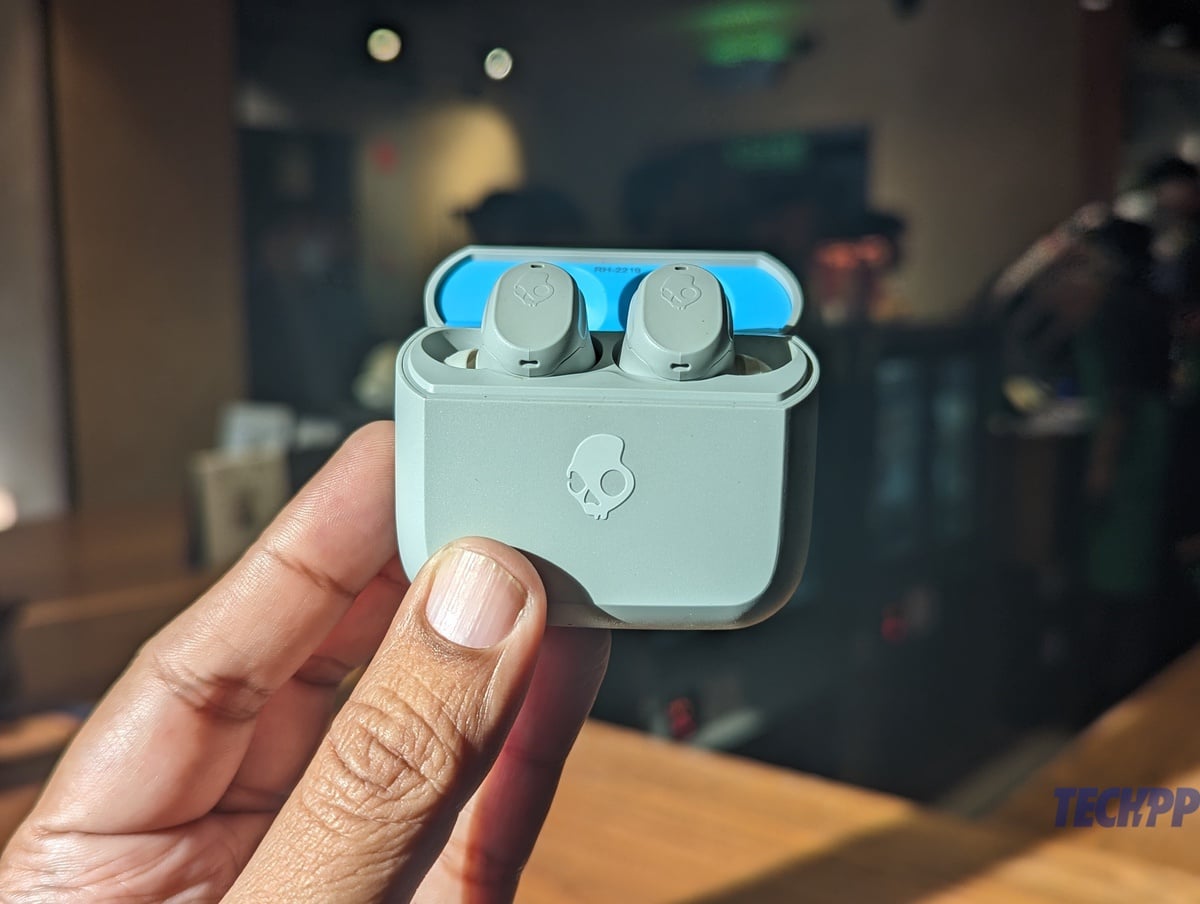The Ascend series has typically carried the flagship mantle from Huawei. But surprisingly, Huawei chose the Honor series to have the honor of being the first smartphone with the new HiSilicon Kirin 920 SoC which is an octa-core processor made of four Cortex-A15 cores and four Cortex-A7 cores. That’s kind of a big deal for us geeks, but what about the end users? Does Honor 6 has enough stuff to warrant a look into your pockets? We find out.
Design & Build
On first look, the design of Huawei Honor 6 can be considered modest. When it’s lying around with other phones in our testing labs, hardly anyone would bother to take note of it, as the looks are quite nonchalant by today’s standards. Huawei has clearly not tried too hard to make Honor 6 a looker. The phone has this iPhone 4 like design with minimalistic glass front and back. The glass back has a dotted texture which is hardly visible on first look. The sides are made of plastic which have metallic finish to it. This combination of glass back and plastic sides make the phone feel a bit slippery.
Huawei has gone for an extremely minimalistic design, so much so that you won’t find the company’s logo anywhere. There’s just the honor logo on the back, and people would find it tough to associate this device with Huawei. (Update: Huawei made it clear to us that Honor will be a sub-brand of Huawei which will be sold exclusively online). In addition to being slippery, the glass back is also a fingerprint magnet, much like the Xperia Z series of smartphones from Sony. Being completely flat makes the back scratch prone as well. All in all, the device screams for a case to attain longevity.
Talking about the button and ports placements, Huawei has done pretty well to have the power button bang on the middle of the right panel. This makes it easily accessible on both left handed and right handed usage. The volume rockers are placed just above the power button. The left panel is completely bare, as Huawei has placed the microSIM slot and the microSD slot on the right side as well. Like Sony, Huawei has gone with the annoying flap to cover the SIM and microSD slots, but then you don’t need to open them frequently to worry too much. The microUSB 2.0 port is place on the bottom middle alongside the primary microphone. On top is the 3.5mm audio jack, along with the noise cancellation mic & the IR Blaster (with a twist you’ll find out later in the review). On the front, we have the earpiece surrounded by a notification LED & ambient sensor on left and a 5MP selfie camera on the right. On the rear is the primary 13MP camera with dual LED flash on top and a mono speaker grill on the bottom.
Display
The Huawei Honor 6 comes with a 5-inch Full HD 1080 x 1920 pixels LCD display with a pixel density of 445 pixels per inch. That sounds great right? Well, it looks great as well. It offers excellent brightness (over 500 nits) and is very visible in bright conditions. Sunlight legibility is above average as well. Sadly, the panel is non-IPS which means that the viewing angles aren’t that great. It’s not the most accurate display panel, but Huawei has done well to provide an option to choose color temperature settings.
One interesting settings which we found on Honor 6 is the “Screen saving mode” which effectively reduces the display resolution to 720p from 1080p. Huawei just mentions that you’ll be able to increase the battery life by 20% with this mode without mentioning that they are actually scaling down the resolution. This is the first time we have seen such an option from an OEM. For anyone who thinks a Full HD panel is a waste of resources, they can happily turn to HD. Honestly, we had to struggle a bit to see the difference in quality in general usage as Huawei seems to be up sampling to 1080p.
Hardware
As we briefly mentioned at the beginning, Honor 6 is the first phone to come with Huawei’s HiSilicon Kirin 920 SoC. It’s the first non-Samsung big.LITTLE chip and a successor to Kirin 910T which shipped with Ascend P7. It comes with 4x Cortex A7 and 4x Cortex A15 cores clocked at 1.3GHz and 1.7GHz respectively. What all these should mean to a general consumer? This should ideally offer high performance without eating up too much battery life. Does it actually do that? We shall see that in the Performance section later in the review.
The Kirin 920 CPU is accompanied with Mali T628MP4 GPU and 3GB LPDDR3 RAM. This combination results in some impressive benchmarking scores. The device is pretty sleek with just 7.5mm thickness and weighs 130g. It comes with 16GB of internal storage with the microSD slot capable of expanding storage by up to 64GB. Connectivity options include Bluetooth 4.0, Dual-band WiFi 802.11 a/b/g/n, Cat-6 LTE, DLNA and more. There’s a 3100mAh non-removable battery to power all these.
Software
Honor 6 runs the near latest Android 4.4.2 KitKat with Huawei’s own Emotion UI 2.3 on top of it. Emotion UI or EMUI takes inspiration from multiple custom ROMs present in the market. There’s a touch of MIUI, CyanogenMod and stock android. The overall UI design looks a bit cartoonish to start with with colorful icons all around. At a time when everyone’s going for flatter UI, the Emotion UI looks a bit too old in comparison.
Like most Chinese ROMs, there’s no app drawer on EMUI. Apps and widgets are arranged on the homescreen (much like the iOS), so be prepared for endless scroll of homescreen pages if you have installed lot of apps (and not a fan of creating folders). EMUI comes with a host of features which can look a bit overwhelming for newbies, but geeks would love them. The lock screen looks great with pre-installed wallpapers which randomly show up every time the display comes out of sleep. Dragging up from bottom provides iOS control center like shortcuts for nifty things like torch, mirror, calculator etc. There’s also a nice animation while unlocking the phone which gradually reveals the homescreen as you swipe across.
The notification panel reminds us for Asus’ ZenUI with color choices. There are two tabs available – the notifications and shortcuts. Thankfully, Huawei lets users to open the tab of their choice. Swiping from top left open the notification tab, while swiping from right opens the Shortcuts tab. A very nifty trick indeed.
The Settings page is more like stock Android in its implementation, but obviously provides greater flexibility and options. Other than the usual connectivity, privacy, security, accounts and apps sections, EMUI has ‘Smart Assistance’ options which includes ‘Suspend button’ which provides iOS like on-screen controls, motion controls like flip to mute, raise to ear, shake to rearrange etc., and gloves mode as well. If you’re not happy about the default theme, there’s a theme manager app which provides a wide variety of user developed themes ranging from sketches to sports to abstract ones. It also supports custom settings with which you can replace wallpaper, fonts, etc. by yourself.
Other built-in apps include Phone Manager which scans the phone for unwanted files, cleans up RAM and scans for resource hogging background apps. There’s also a Power Saving mode which can smartly enhance the battery life, Harassment Filter – which can block phone calls and messages from annoying people, a Do-Not-Disturb mode which lets you receive calls only from allowed contacts, Networked Apps – which lists all the apps on the basis of data bandwidth they consume (and you can also restrict them individually from using mobile data and/or WiFi), Notification Manager which lets you control which app can send (or not send) push notifications and finally, the Backup app.
The default music app can categorize songs on the basis of mood – Happy, Serene, Sad and Energetic. It also has a lock screen widget for quick controls. The Weather and calendar apps have live notification app icons (like iOS and MIUI). There’s also a File Manager which supports USB-OTG. Kingsoft Office comes pre-installed. The Tools folder includes small nifty apps like Mirror, Magnifier, Flashlight, Notes, FM Radio, Sound Recorder, App Manager and others. One app which is missing is the Universal Remote Control. Huawei Honor 6 comes with an IR blaster, but for some reason, the Indian build of EMUI has no remote control app. Sadly, even third party apps like Smart IR Remote from Anymote don’t work.
Performance
The Kirin 920 octal-core CPU along with Mali T628MP4 GPU and 3GB LPDDR3 RAM form the performance base of Honor 6. Just for the benchmarking junkies, we shall quote some of the scores. On Antutu, Honor 6 scored almost 40,000. On Basemark graphics test, it scored a respectable 15800 and on 3DMark it scores 14000. Now that we are done with benchmarking, let’s talk about the actual real-world performance. The Honor 6 is a great performer overall.With all those animations and transitions thrown in, there’s hardly any lag while navigating across the screens even with multiple apps running in the background. EMUI is very fluid and coupled with a nice touchscreen experience, it’s pleasant to operate this smartphone. Honor 6 was able to run most of the games we threw at it, and that too at high graphics settings. Playing games like Asphalt 8, Riptide GP 2 and Shadow Gun were a delight on the 5″ Full HD screen. 3GB RAM ensured that there’s no stutter even when multitasking with resource intensive apps running in the background. The best part was that the phone hardly ever got heated up even after playing these games at a stretch. 3100mAh battery on Honor 6 sounds like a big deal, but considering it needs to power a 5-inch 1080p display with an octal-core processor and 3GB of RAM, that wouldn’t sound as big. But Huawei has managed to optimize the chipset and GPU to a great extent. It easily lasted a day of heavy use, and could chug on for a day and a half under normal usage. Utilizing special features like ‘screen saving mode’ and ‘power saving mode’, users can enhance the battery life even further. Huawei is showing its might with the connectivity options thrown in. The phone supports Wi-Fi 802.11ac, Wi-Fi Direct, Bluetooth 4.0 and GPS. It offers 3G and 4G connectivity, although one would need to wait for 1800MHz based 4G LTE networks to launch in India.
Camera
The results from 13MP rear camera and 5MP front camera were greatly mixed in our tests. On paper, Huawei has managed to put a nice 13MP Sony BSI sensor with a F2.0 28mm wide angle lens and dual-LED flash. The camera UI is pretty basic with modes like Panorama, HDR, Beauty, all-focus and multiple filters thrown in. It does lets you adjust the exposure, saturation and contrast if you wish. Below we have some sample images, shot in various lighting conditions. The primary camera on Honor 6 does manage to take some decent shots in good lighten conditions, but HDR mode is hardly consistent. It’s more of a hit and miss and you’re required to take several pictures because the metering algorithm was very unpredictable. The pictures taken from the front camera too lack sharpness and details. Considering its a 5MP snapper, that’s quite a bummer. You can record 1080p videos, but lack of OIS is very apparent. Software based stabilization is present, but it greatly reduces the video image quality. Overall, the cameras on Honor 6 have to be one of the weaker points of the phone.
Conclusion
At Rs.19,999 (~$325), Huawei’s Honor 6 is extremely well priced. Huawei has managed to be aggressive with their pricing, by spinning off Honor as an online-only brand, thereby passing on the distribution margin costs to the end users. It carries top notch hardware while selling at affordable prices. Emotion UI has matured to be an impressive Android skin without looking like a bloatware. EMUI 2.3 adds a lot of customization options and nifty features without hampering the Android KitKat performance. EMUI 3.0 is due anytime now and should see even more features added to this impressive device.
HiSilicon’s Kirin 920 along with 3GB of RAM provides great performance. Gaming is a delight on Honor 6 and so is the battery performance. The GPU could have been better, but then Huawei must have chosen Mali T628 to optimize the battery performance. The phone’s looks & build are minimalistic, but not cheap. The Camera is its weakest link. At this price, Honor 6 will soon be taking on the likes of OnePlus One and Xiaomi Mi 4, both of which are expected to launch before the end of the year in India. It won’t be easy for Honor 6 if OnePlus and Xiaomi price their devices aggressively, but till then, Honor 6 should be the phone to beat under Rs.20,000 ($349) category.

















